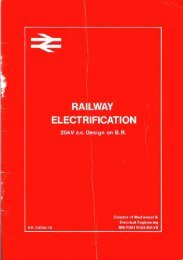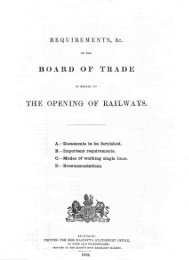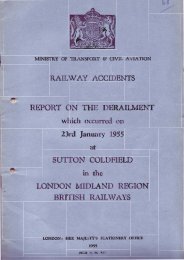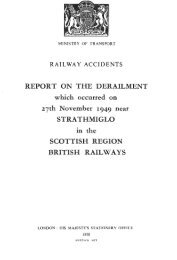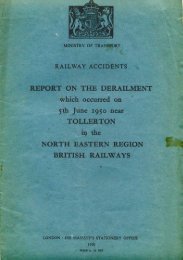R A I LT R AC K - The Railways Archive
R A I LT R AC K - The Railways Archive
R A I LT R AC K - The Railways Archive
Create successful ePaper yourself
Turn your PDF publications into a flip-book with our unique Google optimized e-Paper software.
developing<br />
62<br />
6.1<br />
<strong>The</strong>re is a core<br />
commercial network<br />
of long-distance<br />
passenger services for<br />
which growth can be<br />
accommodated through<br />
investment that has a<br />
commercial return<br />
6.1 Passenger markets<br />
<strong>The</strong> passenger market can be categorised broadly into:<br />
• Long distance services<br />
• Urban services<br />
• Rural services<br />
• Access to airports and ports.<br />
Long distance services<br />
<strong>The</strong>re is a core commercial network of long-distance<br />
passenger services for which growth can be accommodated<br />
through investment that has a commercial return.This is<br />
supported by our customers' own plans to meet growing<br />
demand.Our strategy is to work with our customers to<br />
develop their businesses and to increase the number of<br />
passengers travelling on their services.Our main contribution<br />
is usually the investment necessary to reduce journey times<br />
and to ensure that there is sufficient network capacity to<br />
handle increased frequencies.In addition,the radical<br />
timetable restructuring that is necessary is being promoted<br />
through a new collabora t i ve approach involving all opera t o rs –<br />
both passenger and freight – with the objective of the<br />
highest possible level of network use.<br />
Access to London<br />
Public transport accounts for around 80% of central London<br />
journeys to work and almost 50% of these use national rail<br />
as the main mode of travel.Most independent forecasts<br />
suggest that employment in central London will continue to<br />
grow steadily, putting increasing strain on our network.On<br />
most major corridors,the railway is already operating at,or<br />
close to, maximum peak capacity and we are devoting<br />
considerable energy to the development of enhancements<br />
that will enable rail to cope with traffic increases well into<br />
the next millennium.<br />
<strong>The</strong>se enhancements generally need to be developed in<br />
partnership with public bodies,both because of the planning<br />
issues involved and because the schemes are not<br />
economically viable without taking account of the social<br />
benefits they bring.<br />
Urban network development – Scotland, Wales<br />
and the English regions<br />
<strong>The</strong> economic and social development of cities in Scotland,<br />
Wales and the English regions provides one of the strongest<br />
challenges to turn the concept of integrated transport into<br />
reality. Choices exist both in the short and long term as to<br />
how to optimise the economic benefits of integrating good<br />
highway planning and commercial land-use developments,<br />
particularly on the edge of existing conurbations,while<br />
sustaining the viability and cohesiveness of the established<br />
business,shopping,leisure and residential core of inner and<br />
central city areas.For the same reasons as in London,<br />
partnership with public bodies is essential.Planning<br />
authorities have recognised that the core attributes for public<br />
transport in a good policy on integrated transport are likely<br />
to include physical accessibility, clarity of,and access to,<br />
information and ticketing,and safety and comfort in the<br />
travel and waiting environments.<br />
Rural services<br />
Population densities in rural areas are relatively low, and high<br />
levels of public sector support are normally required to fund<br />
public transport services.<strong>The</strong> rail network often provides a<br />
vital means of social accessibility for those in local<br />
communities who either do not have access to a vehicle , or<br />
prefer not to drive. Prospects for economically viable growth<br />
strategies based on infrastructure enhancement are limited<br />
but there are many initiatives where we work with local<br />
public sector agencies to continue to promote the<br />
development of train travel.<br />
Access to airports and ports<br />
Growing demand for international travel, for both business<br />
and leisure, is putting pressure on surface access to airports<br />
and ports. We are working with a number of operators of<br />
such facilities to develop high-quality rail access.Examples<br />
include:<br />
London airports. Gatwick Airport has, for a number of<br />
years,enjoyed high-quality rail links to central London.<br />
Capacity improvements for additional services,including<br />
those provided by long-distance operators,is being<br />
considered for the Brighton Main Line.



